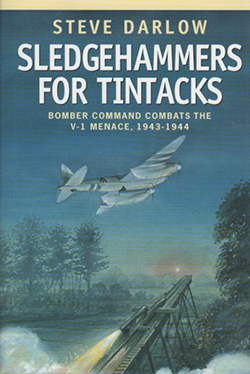
The Bomber Command raid to the V1 flying bomb supply depot at St Leu d’Esserent on 7/8 July 1944 met with considerable opposition, resulting in one the worst nights of the whole war for the RAF bomber force over France. The following is an account of how the night unfolded, from the book ‘Sledgehammers for Tintacks’ by Steve Darlow.
RAF Bomber Command despatched two large forces to French targets that night. One involving 123 Lancasters and 5 Mosquitos, to the rail yards at Vaires, 12 miles east of Paris, the other involving 208 Lancasters and 13 Mosquitos to visit the flying bomb supply depot at St Leu d’Esserent.
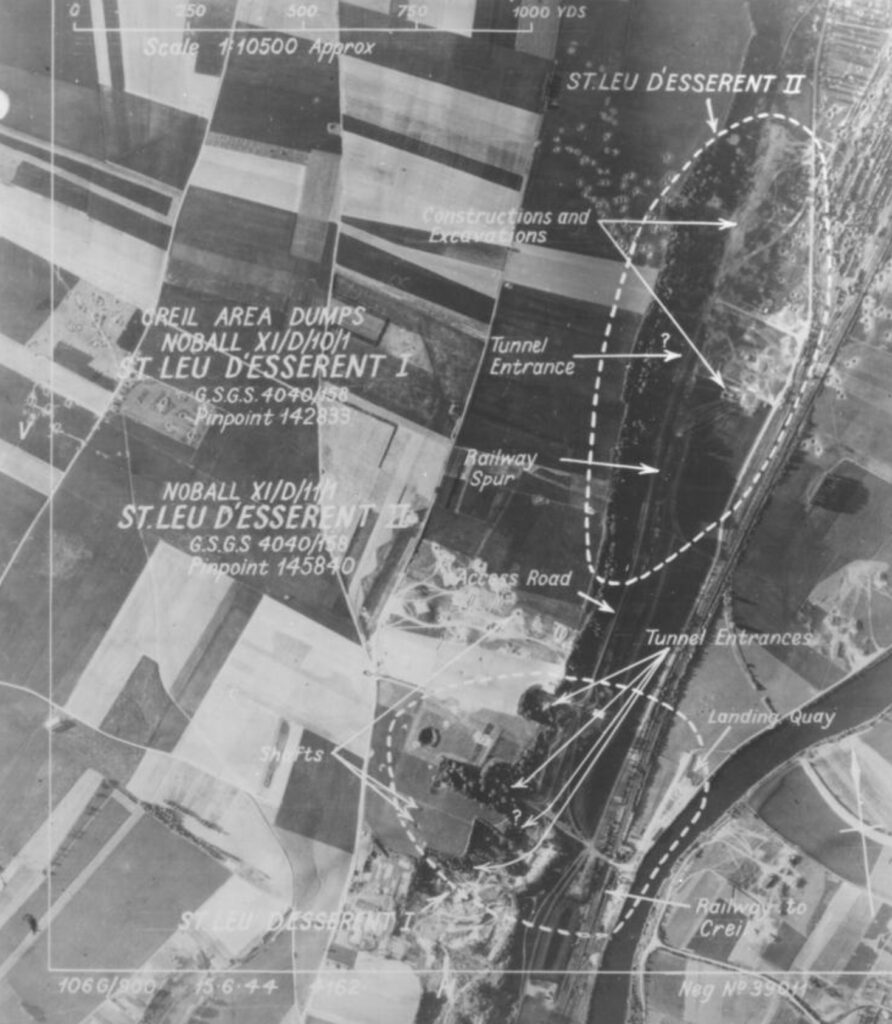
One hundred and six aircraft (Lancasters, Halifaxes, Stirlings and Wellingtons) were sent on a diversionary raid over the North Sea to the coast of Holland, 32 Mosquitos were sent to Berlin and 9 Mosquitos to Scholven/Buer. Fifty-four aircraft were employed on RCM and Resistance operations. Sixteen Stirlings operated a Mandrel screen and 45 Mosquitos made Serrate and intruder patrols; 16 Mosquitos were involved in anti-flying bomb patrols.
Bomber Command planned an interesting ruse for the night’s operations. The force sent to St Leu d’Esserent was directed to form three waves on the outward route. The largest wave, of approximately 100 aircraft, being half the force, would share their approach route with the Vaires force. Over France and to the west of Paris the Vaires force would then continue south whilst the St Leu d’Esserent wave would turn towards a rendezvous point for all the three waves to the south-west of St Leu d’Esserent. The aim of this exercise was to try and suggest to the Germans that raids involving 200-plus bombers were to take place to the south of Paris with smaller raids on flying bomb sites to the north.
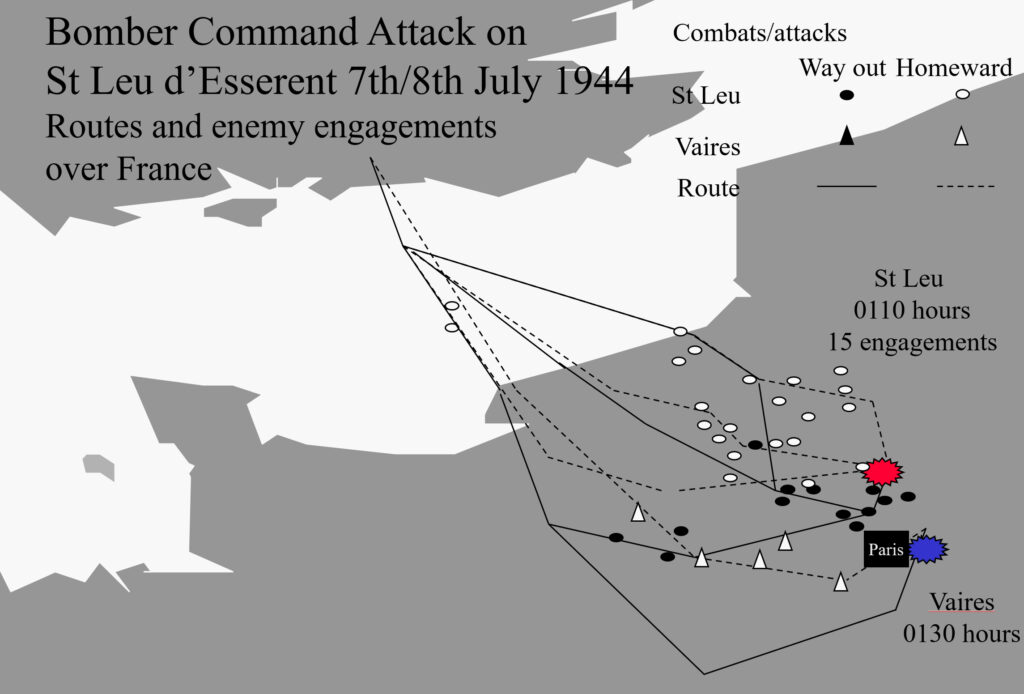
Plan of attack for St Leu d’Esserent
208 Lancasters and 13 Mosquitos
Zero hour – 0110 hours
Mosquitos to locate the aiming point at zero hour – 4. Then Oboe Mosquitos were to drop yellow route indicator TI. At zero hour, if the Controller required, the target was to be illuminated. The aiming point was to be marked with red spot fires and green red TI, and backed up if accurate. Yellows were to be used to cancel wide markers. In a further attempt to confuse prowling opposition nightfighters and draw them away from the real bombing target, RAF ‘spoof’ (diversionary) aircraft would drop red, green and yellow TI approximately 50 miles to the north east of the St Leu d’Esserent target area, at zero hour – 12.
Time over France 0022 to 0158 hours, time over the target 0110 to 0125 hours.
The time over the target for the Vaires force was ordered for 0123 to 0136 hours with time over France as 0022 to 0158 hours. The diversionary force was ordered to be at a longitude position 3 degrees east, heading toward the Dutch coast, at 0100 hours, the hope being that this would draw the defensive German nightfighters north away from the actual main bombing targets. A Mandrel Screen was also to be used, in an attempt to further confuse the German defenders’ control of the nightfighters. Bomber Command’s weather forecast for the night suggested good clear areas in France with little cloud at Paris. Below is the detail of the night’s operations.
2330 to 0015 hours
St Leu d’Esserent force: The large force proceeds across the Channel and then splits into three waves mid-way across. Approaching the French coast.
Vaires force: Proceeds across the Channel on the same route as the St Leu d’Esserent force and then with the St Leu d’Esserent third wave when this splits. Approaches the French coast.
German reaction (from Allied Intelligence intercepts): German controller starts assembling fighters at the beacons between Beauvais and Creil and between Creil and Paris. I./NJG 5 sent to the north of Paris and I./NJG 4 sent from the Cambrai area to the Beauvais/Creil area.
0016 to 0030 hours
St Leu d’Esserent force: The first two waves cross the French coast and proceed south-east towards the target. The third wave crosses the coast just to the east of Le Havre, with the Vaires force.
Vaires force: Crosses the French coast just to the east of Le Havre and proceeds south-south-east.
German reaction: At 0018 hours the RAFs bombers were plotted to the south of Beachy Head. At 0023 hours I./JG301 from St Dizier were readied and at 0029 hours sent to a concentration of searchlights in the Dieppe area.
0031 to 0045 hours
St Leu d’Esserent force: The first two waves proceed south-east towards the target area. The third wave prepares to turn eastward and departs from the Vaires force.
Vaires force: Continues south-east across France.
German reaction: At 0043 hours I./NJG 5 is positioned north of Paris and awaits orders. At 0044 hours I./JG301 is ordered towards the mouth of the Somme, receiving information that the bombers were in the area and at Le Tréport.
Combats (100 Group): At 0040 hours a 239 Squadron Mosquito closes in on an FW190, 8 miles north-west of Amiens. From dead astern the Mosquito opens fire, striking the single-engined nightfighter which explodes violently and scorches the Mosquito’s port wing. The burning debris of the FW190 cascades to the ground.
At 0041 hours a 239 Squadron Mosquito sights an Me110 in the Meaux area and sends a two second burst of cannon fire into the enemy aircraft’s fuselage and port engine, which explodes. Smoke trails the stricken Me110 as it descends rapidly, with further explosions, and hits the ground.
0046 to 0100 hours
St Leu d’Esserent force: All three waves converge on a position just to the south-south-west of the target. Aircrews begin to witness the demise of some of their RAF colleagues.
The whole crew bales out of Flying Officer Mather’s RCAF 106 Squadron Lancaster owing to fire in both port engines and in the rear fuselage. All men survive and their aircraft burns near Gournay-en-Bray.
Pilot Officer Monaghan’s RAAF crew bale out of its 106 Squadron Lancaster, over Anet, and all men survive.
Flight Lieutenant Ball DFC and his crew all lose their lives as their 44 Squadron Lancaster is believed shot down by friendly fire from another Lancaster. The aircraft burns near the village of le Chesne.
Vaires force: Proceeds south-east to turn north-east towards the target.
German reaction: Some fighters are held north due to the diversionary raids. Engagements between fighters and bombers begin against all three of the St Leu d’Esserent waves.
Combats (100 Group): At 0050 hours a 141 Squadron Mosquito stalks an Me110, opens fire and strikes are seen along the top of the German nightfighter’s mainplane. A large explosion results and the aircraft turns on its back, dives to earth and explodes on the ground.
At 0053 hours the 239 Squadron Mosquito that had claimed a kill at 0041 hours sights another Me110, 5 miles south of Compiègne, and opens fire from dead astern and slightly below. The middle of the enemy aircraft is hit and it explodes; oil and burning wreckage fly back, the oil covers the victorious Mosquito’s windscreen. What is left of the German nightfighter falls from the night sky and explodes on the ground.
Other forces: Spoof attack starts at 0100 hours with little effect. The diversionary force turns back over the North Sea.
0101 to 0115 hours
St Leu d’Esserent force: The three waves converge, approach and attack the target. Stricken RAF bombers, going down, continue to be witnessed and recorded by more fortunate bomber crews.
All four engines on Flight Lieutenant Marchant’s RAAF 106 Squadron Lancaster are set on fire and the aircraft rapidly descends to smash into the ground near Anet. Only the pilot and two other men from the crew of seven survive.
Flight Sergeant Boyce is killed along with four of his crew (two men survive) as their 207 Squadron Lancaster falls to the ground near Haudricourt.
The 83 Squadron Lancaster of Flying Officer Griffiths DFC is shot down. The pilot dies and of the crew of seven only two survive. The fallen bomber burns near Bû.
A direct flak hit causes the explosion of the 61 Squadron Lancaster of Pilot Officer Passant RAAF. There is a total loss of life as the debris cascades to the ground near the town of Mouy.
Vaires force: Proceeds north-east towards the target area.
German reaction: At 0105 hours the first bombers start to reach St Leu d’Esserent, close to where I./NJG5 is assembled. Bomber Command’s radio intercepts start to pick up German victory claims. Numerous engagements occur up to and over the target.
0116 to 0130 hours
St Leu d’Esserent force: Over the target and then splits into three waves for the return route with further losses.
A nightfighter attack results in the death of 207 Squadron’s Flying Officer Stamp and 2 of his crew. The 4 other crew members survive the Lancaster’s destruction in the sky over Auvers-sur-Oise
The 44 Squadron Lancaster of Pilot Officer Gowing crashes near Neufchâtel-en-Bray. Five men survive, the pilot and the other crew member are killed.
A nightfighter shoots down the 49 Squadron Lancaster of Flying Officer Baker, over Beauvoir-en-Lyons, and there are no survivors.
Flight Lieutenant Grantham is killed along with four of his crew (the other two men surviving) as their 61 Squadron Lancaster falls near Moliens.
Squadron Leader Marshall DFC loses his life along with his entire crew as their 106 Squadron Lancaster falls to earth near Ste-Geneviève, after being hit by flak.
Flying Officer Alderton and his entire crew manage to get out and survive as their 207 Squadron Lancaster hits the ground near Songeons.
Pilot Officer Milner dies and there is only one survivor from his crew of seven as their 207 Squadron Lancaster falls to earth near Gisors.
Wing Commander Deas DSO DFC and Bar, is killed with five of his crew, one man surviving, as their 630 Squadron Lancaster falls near Villers-en-Arthies.
Vaires force: Approaches and attacks the target.
German reaction: The battle over St Leu d’Esserent continues and the bomber force suffers numerous losses. The fighters start to give chase and engage with the bombers along the home routes.
0131 to 0145 hours
St Leu d’Esserent force: Proceeds homeward in three waves, still suffering losses.
57 Squadron Pilot Officer Owen and his crew manage to get out of their Lancaster, and all men survive, before it crashes near Montdidier.
Flying Officer Hordley is killed with four of his crew, two men survive, as their 207 Squadron Lancaster falls to ground near Sancourt.
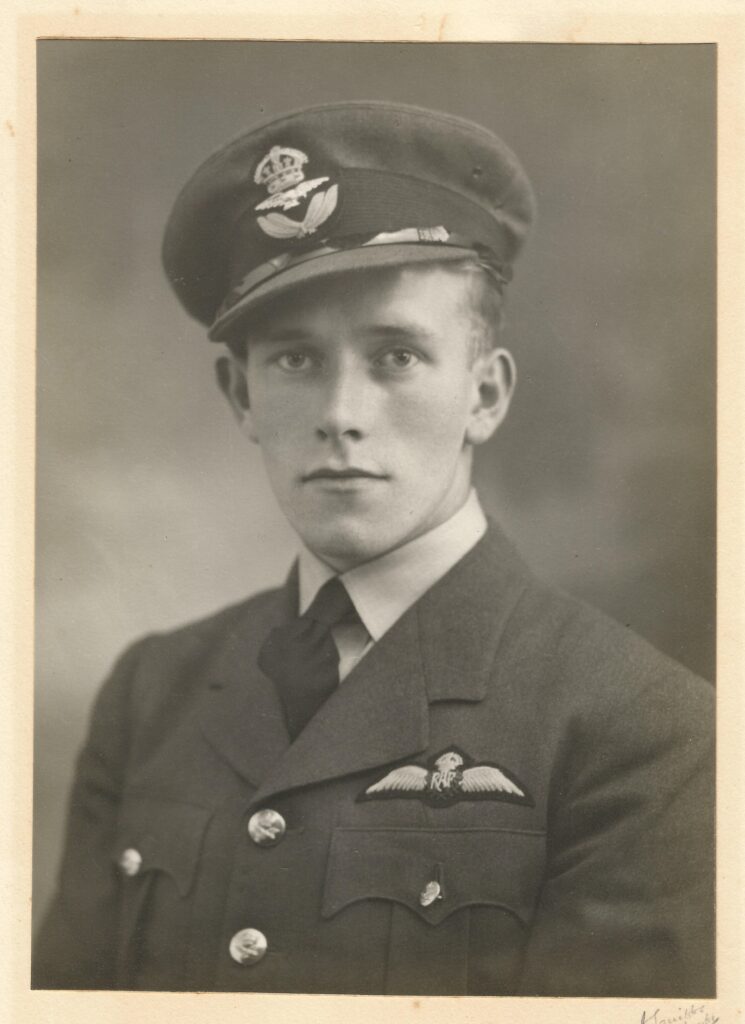
Flight Lieutenant Johnston survives with four of his crew, the other two men dying, as their 619 Squadron Lancaster plunges to the ground near Précy-sur-Oise.
Vaires force: Attacks the target and then proceeds south-west and then west, away from the target.
German reaction: The air battle rages on the St Leu d’Esserent force homeward route. At 0131 hours I./JG301 is told to wait between Dieppe and some searchlights; at 0134 hours they were told that the bombers would be over the mouth of the Somme within 5 minutes.
Combats (St Leu d’Esserent Force): At 0133 hours an 83 Squadron Lancaster is attacked by a single-engine enemy aircraft. The bomber’s gunners return fire, seeing it hit their adversary’s wing roots and fuselage. A glow appears which eventually bursts into flames and the German nightfighter plunges and explodes on the ground.
Combats (100 Group): At 0135 hours, south-east of Charleroi, a 239 Squadron Mosquito closes on an Me110 and opens fire. Strikes are witnessed in the middle of the aircraft’s fuselage. The Me110 explodes and pieces of wreckage fly past the Mosquito. What is left of the German nightfighter aircraft hits the ground and burns.
0146 hours onwards
St Leu d’Esserent force: The three waves proceed, with a few burning bombers seen to fall, towards the French coast and converge on a point mid-Channel from where the bombers proceed on to Reading.
Pilot Officer Langford’s 9 Squadron Lancaster falls to earth near Gamaches, with only the pilot and two other men surviving.
Flight Lieutenant Carnegie’s 44 Squadron Lancaster is shot down by a nightfighter, crashing near St-Germer-de-Fly.
A nightfighter shoots Sergeant Lloyd’s 50 Squadron Lancaster out of the sky over Grandvillers, with a total loss of life.
RCAF Pilot Officer Laidlaw’s 50 Squadron Lancaster explodes over Mesnil-Mauger, throwing clear the pilot, who is the only survivor.
Pilot Officer Rose RAAF is killed along with two of his 57 Squadron crew and one of the crew is fatally injured. Three men survive the Lancaster’s demise, which comes to earth near Fresnay-le-Long.
The 57 Squadron Lancaster of Pilot Officer Findley falls to the ground near St-Nicolas d’Aliermont with a total loss of life.
Vaires force: Turns north-west and crosses the French coast to the north of Le Havre and from there proceeds on to Reading.
German reaction: There are a few engagements with the Vaires Force and a few further engagements with the St Leu d’Esserent force.
Over the target the St Leu d’Esserent force had experienced variable cloud 3 to 10/10ths at 15 to 17,000 feet, clear below. The moon was up all night and just past full, perfect for the prowling nightfighters. Bomber Command believed the target was marked accurately, but there had been delay. It was hoped that the opening markers could be placed using the light of the moon, but flares were needed. This resulted in the main force having to orbit, giving more time for the German nightfighters to intercept. Bombing was believed accurate with a slight southerly drift towards the end of the raid. Apart from the attention of the nightfighters there was considerable heavy flak, much stronger than the force on the 4/5 July raid experienced. There were no searchlights over the target. Subsequent day reconnaissance showed concentrations of craters over the northern, central and southern tunnel entrances, with buildings destroyed. The main railway was also hit and 13 craters were counted on the tracks from the tunnel entrances. A gun position received a direct hit. In terms of damage caused this raid could certainly be classed as successful. Colonel Walter, Chief of Staff to LXV Army Corps was to later recall the conditions in the caves following the attacks:
You could hear a constant rumbling overhead, and began to feel that the very mountain was on the move and might collapse at any moment. It was asking too much of any man’s nerves to expect him to hold out in caves like that.
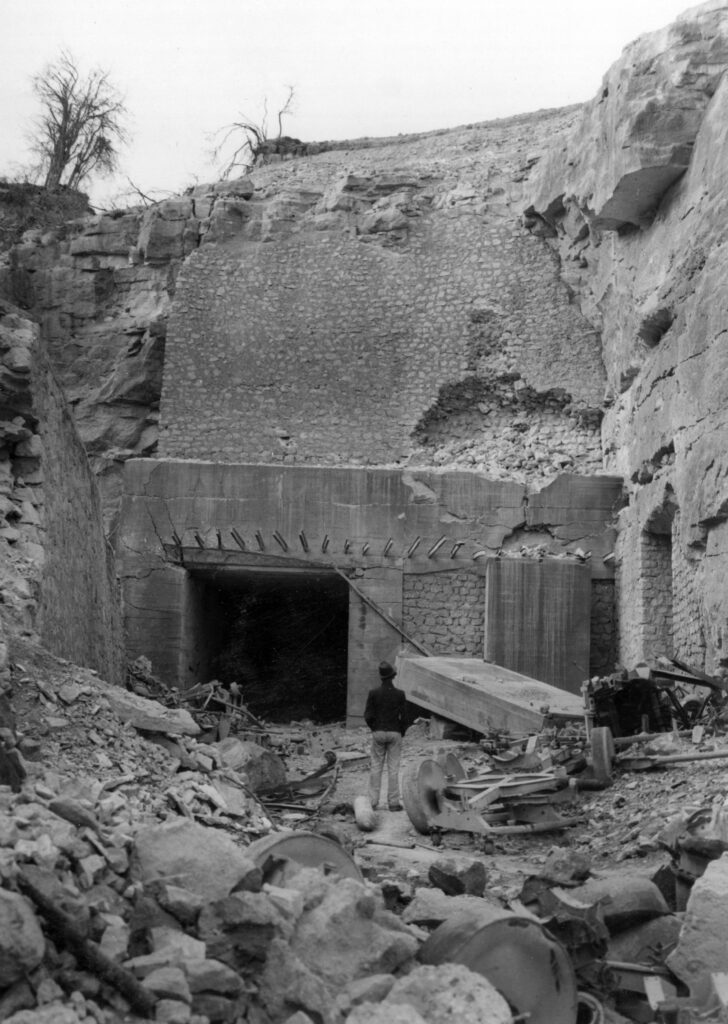
Air Vice-Marshal Cochrane, Air Officer Commanding 5 Group, wrote a congratulatory note to his aircrews:
All members of aircrew taking part in Friday night’s attack on St Leu have reason to feel proud of their achievement. Day photographs show concentration of bombs on and around the Aiming Point, which would have been considered excellent had there been no opposition. In the circumstances, the accuracy achieved is a magnificent tribute to Captains and Crews. It is now known that the enemy ignored all other attacks that night in order to concentrate his whole strength in defence of this one target. He brought to bear some 100 twin and 50 single-engined fighters, many being concentrated over the target. Losses would have been heavier had it not been for the excellent discipline and strict adherence to Flight Plan, especially the timing of the attack and the dispersal after leaving the target. The plotted positions of aircraft twenty minutes after bombing shows an even spread over a front of 60 miles, and in height between 5 and 20,000 ft. As a result, interceptions quickly diminished after leaving the target. Although the cost of the operation was high, it achieved its purpose, and has received from the Press the recognition which you so fully earned. I believe it to be the best achievement yet put up by No. 5 Group, and an indication to the Germans that even under conditions most favourable to them, they are still unable to stop attacks on the targets they value most highly. Well done.
The cost to Bomber Command had indeed been high. The German nightfighters had been carefully marshalled. Bomber Command lost a total of 32 Lancasters as a result of the raid to the flying bomb supply depot. One hundred and forty-two men were killed in these aircraft, 30 men became POWs and 47 men evaded capture. For a raid to a target in France these losses were extremely high. There were no losses at all on the raid to Vaires. There had been a cost to the German nightfighter force for their success. On the night’s operations 100 Group Mosquitos claimed five enemy aircraft and two main force Lancasters claimed an enemy aircraft each. In addition Air Defence of Great Britain Mosquitos claimed three Ju88’s, one Ju 188 and one unidentified aircraft.
Be First to Comment